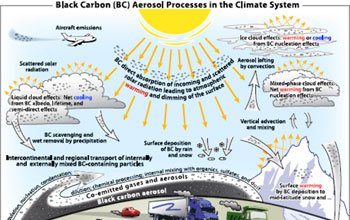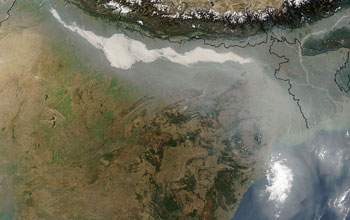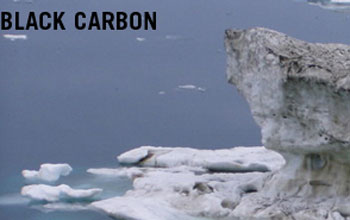Hola amigos: A VUELO DE UN QUINDE EL BLOG., hemos recibido una interesante información de The National Science Foundation (NSF), sobre la disminución las emisiones de carbón negro, metano y otros agentes contaminadores hacen una diferencia. Como dice el recorte de Agentes contaminadores Específicos Atmosféricos Reduciría la marcha Subida de Nivel del Mar.
Con áreas costeras frescas para niveles crecientes de mar, la nueva investigación indica que el recorte de las emisiones de ciertos agentes contaminadores enormemente puede reducir la marcha la subida de nivel de mar este siglo.
Los científicos encontraron que reducciones de cuatro agentes contaminadores por los cuales el ciclo relativamente rápidamente por la atmósfera temporalmente podría prevenir la subida de nivel de mar aproximadamente el 25 a 50 por ciento.
Amigos les invito a leer la versión original en inglés............

Black carbon, a short-lived pollutant (shown in purple), shrouds the globe.
Credit: NOAA
Download the high-resolution JPG version of the image. (102 KB)

The path to black carbon: where it comes from, where it goes.
Credit: NOAA
Download the high-resolution JPG version of the image. (373 KB)

Image showing thick haze and smoke along the Ganges Basin in northern India.
Credit: NASA
Download the high-resolution JPG version of the image. (218 KB)

Controlled burns release huge amounts of sooty black carbon into the atmosphere.
Credit: USCG
Download the high-resolution JPG version of the image. (289 KB)

Soot in exhaust spews out black carbon.
Credit: US EPA
Download the high-resolution JPG version of the image. (22 KB)

Black carbon enters the atmosphere, then returns to land and sea.
Credit: NOAA
Download the high-resolution JPG version of the image. (111 KB)
With coastal areas bracing for rising sea levels, new research
indicates that cutting emissions of certain pollutants can greatly slow
sea level rise this century.
Scientists found that reductions in
four pollutants that cycle comparatively quickly through the atmosphere
could temporarily forestall the rate of sea level rise by roughly 25 to
50 percent.
The researchers focused on emissions of four
heat-trapping pollutants: methane, tropospheric ozone,
hydrofluorocarbons and black carbon.
These gases and particles
last anywhere from a week to a decade in the atmosphere and can
influence climate more quickly than carbon dioxide, which persists in
the atmosphere for centuries.
"To avoid potentially dangerous sea
level rise, we could cut emissions of short-lived pollutants even if we
cannot immediately cut carbon dioxide emissions," says Aixue Hu of the
National Center for Atmospheric Research (NCAR) in Boulder, Colo., first
author of a paper published today in the journal Nature Climate Change.
"Society can significantly reduce the threat to coastal cities if it moves quickly on a handful of pollutants."
The research was funded by the National Science Foundation (NSF) and the U.S. Department of Energy.
"Sea
level rise and its consequences present enormous challenges to modern
society," says Anjuli Bamzai, program director in NSF's Division of
Atmospheric and Geospace Sciences, which supported the research.
"This
study looks at projections of global sea level rise, unraveling the
effects of mitigating short-lived greenhouse gases such as methane,
tropospheric ozone, hydrofluorocarbons and black carbon, as well as
long-lived greenhouse gases like carbon dioxide," says Bamzai.
It
is still not too late, "by stabilizing carbon dioxide concentrations in
the atmosphere and reducing emissions of shorter-lived pollutants, to
lower the rate of warming and reduce sea level rise by 30 percent," says
atmospheric scientist Veerabhadran Ramanathan of the Scripps
Institution of Oceanography (SIO) in San Diego, a co-author of the
paper. Ramanathan initiated and helped oversee the study.
"The
large role of the shorter-lived pollutants is encouraging since
technologies are available to drastically cut their emissions," says
Ramanathan.
The potential effects of rising oceans on populated areas are of great concern, he says.
Many
of the world's major cities, such as New York, Miami, Amsterdam,
Mumbai, and Tokyo, are located in low-lying areas along coasts.
As
glaciers and ice sheets melt, and warming oceans expand, sea levels
have been rising by an average of about 3 millimeters annually in recent
years (just over one-tenth of an inch).
If temperatures continue
to warm, sea levels are projected to rise between 18 and 200
centimeters (between 7 inches and 6 feet) this century, according to
reports by the Intergovernmental Panel on Climate Change and the U.S.
National Research Council.
Such an increase could submerge coastal communities, especially when storm surges hit.
Previous
research by Ramanathan and Yangyang Xu of SIO, a co-author of
the paper, showed that a sharp reduction in emissions of shorter-lived
pollutants beginning in 2015 could offset warming temperatures by up to
50 percent by 2050.
Applying those emission reductions to sea
level rise, the researchers found that the cuts could dramatically slow
rising sea levels.
The results showed that total sea level rise
would be reduced by an estimated 22 to 42 percent by 2100, depending on
the extent to which emissions were cut.
However, the study also
found that delaying emissions cuts until 2040 would reduce the
beneficial effect on year-2100 sea level rise by about a third.
If
society were able to substantially reduce both emissions of carbon
dioxide as well as the four other pollutants, total sea level rise would
be lessened by at least 30 percent by 2100, the researchers conclude.
"We still have some control over the amount of sea level rise we are facing," Hu says.
Another
paper co-author, Claudia Tebaldi of Climate Central, adds: "Without
diminishing the importance of reducing carbon dioxide emissions in the
long-term, this study shows that more immediate gains from shorter-lived
pollutants are substantial.
"Cutting emissions of those gases
could give coastal communities more time to prepare for rising sea
levels," says Tebaldi. "As we have seen recently, storm surges in
populated regions of the East Coast show the importance of making such
preparations and cutting greenhouse gases."
To conduct the study,
Hu and colleagues turned to the NCAR-based Community Climate System
Model, as well as a second computer model that simulates climate, carbon
and geochemistry.
They also drew on estimates of future
emissions of heat-trapping gases under various social and economic
scenarios and on computer models of melting ice and sea level rise.
The
study assumes that society could reduce emissions of the four gases and
particles by 30-60 percent over the next several decades.
That
is the steepest reduction believed achievable by economists who have
studied the issue at Austria's International Institute for Applied
Systems Analysis, one of the world's leading research centers into the
effects of economic activity on climate change.
"It must be
remembered that carbon dioxide is still the most important factor in sea
level rise over the long-term," says NCAR scientist Warren Washington, a
paper co-author. "But we can make a real difference in the next several
decades by reducing other emissions."
-NSF-
Media Contacts
Cheryl Dybas, NSF (703) 292-7734 cdybas@nsf.gov
David Hosansky, NCAR (303) 497-8611 hosansky@ucar.edu
Robert Monroe, SIO (858) 534-3624 rmonroe@ucsd.edu
David Hosansky, NCAR (303) 497-8611 hosansky@ucar.edu
Robert Monroe, SIO (858) 534-3624 rmonroe@ucsd.edu
The National Science Foundation (NSF) is an independent federal
agency that supports fundamental research and education across all
fields of science and engineering. In fiscal year (FY) 2012, its budget
was $7.0 billion. NSF funds reach all 50 states through grants to nearly
2,000 colleges, universities and other institutions. Each year, NSF
receives about 50,000 competitive requests for funding, and makes about
11,500 new funding awards. NSF also awards about $593 million in
professional and service contracts yearly.
Useful NSF Web Sites:
NSF Home Page: http://www.nsf.gov
NSF News: http://www.nsf.gov/news/
For the News Media: http://www.nsf.gov/news/newsroom.jsp
Science and Engineering Statistics: http://www.nsf.gov/statistics/
Awards Searches: http://www.nsf.gov/awardsearch/
NSF Home Page: http://www.nsf.gov
NSF News: http://www.nsf.gov/news/
For the News Media: http://www.nsf.gov/news/newsroom.jsp
Science and Engineering Statistics: http://www.nsf.gov/statistics/
Awards Searches: http://www.nsf.gov/awardsearch/
The National Science Foundation (NSF)
Guillermo Gonzalo Sánchez Achutegui
ayabaca@gmail.com
ayabaca@hotmail.com
ayabaca@yahoo.com
Inscríbete en el Foro del blog y participa : A Vuelo De Un Quinde - El Foro!

No hay comentarios:
Publicar un comentario